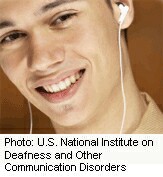
TUESDAY, Aug. 17 (HealthDay News) — The number of U.S. teenagers experiencing hearing loss increased about 30 percent from 1988 to 2006, so that one in five teens now has lost some hearing, researchers report.
“This is a sobering” finding, said Paul R. Kileny, professor and director of audiology and electrophysiology at the University of Michigan Health System, who was not involved in the study.
The hearing loss among teens, Kileny said, is not due to increased exposure to loud noises or the prolonged use of some medications “because they [teens] are way too young to manifest the effects of this exposure or of age-related hearing loss.”
Instead, he said, the loss can probably be “traced back to lifestyle and habits, and for the most part, it’s very likely associated with the increased use of portable MP3 devices.”
For the study, researchers led by Dr. Josef Shargorodsky, from Brigham and Women’s Hospital in Boston, collected data on 2,928 adolescents who took part in the Third National Health and Nutrition Examination Survey, which ran from 1988 to 1994.
They compared these teenagers with 1,771 teens who took part in the same survey from 2005 to 2006.
Among the first group of teens, 14.9 percent had some hearing loss in at least one ear. However, among teens in the more recent study, that number had jumped to 19.5 percent, representing about 6.5 million adolescents — an increase of 31 percent, the researchers found.
Most of the hearing loss was slight and probably would not be noticed by the teens. In addition, in 2005-2006 most of the hearing loss was confined to the high frequencies (16.4 percent). Only 9 percent of the teens had low-frequency hearing loss, Shargorodsky’s team noted.
In addition, hearing loss was mostly in one ear (11.1 percent in 1988-1994 and 14 percent in 2005-2006). Hearing loss in both ears was 3.8 percent in the earlier study and 5.5 percent in the more recent study, the researchers found.
However, among the 2005-2006 teens, the number with “mild” or “worse” hearing loss was 77 percent higher than among teens in the 1988-1994 group. Girls were less likely to have hearing loss, they added.
The increase in hearing loss was not significantly related to a history of ear infections, exposure to firearm use, or exposure to loud noise five or more hours in a week. However, teens from families living below the federal poverty threshold were more likely to have hearing loss than teens living above it, Shargorodsky and colleagues pointed out.
“Further studies are needed to determine reasons for this increase and to identify potential modifiable risk factors to prevent the development of hearing loss,” the study authors concluded in the report published in the Aug. 18 issue of the Journal of the American Medical Association.
Although the reasons behind the increase in hearing loss are unknown, Kileny stressed that portable music devices are the most probable explanation. Hours of listening at a loud volume can damage hearing, particularly in the high-frequency range, Kileny said. “Listening to music at a reasonable level is definitely not harmful, but when you are listening with a set of ear-buds, nobody can know at what level you are listening.”
In addition, the compression of music for MP3 files has removed the dynamic highs and lows in the music. “This means that music, which typically has peaks and valleys, now is mostly just peaks,” Kileny said. “As a result, everything is loud.”
Kileny said the amount of hearing loss is minimal, but it’s a harbinger of things to come.
“It’s more of an indicator of what might come later on. Because once you have created an environment in the inner ear of this nature, it tends to be progressive,” he said. “Over time you can expect the hearing loss will be significant.”
Kileny suggests people set the automatic volume level on their MP3 player to a safe level, which can prevent the music from becoming too loud and causing hearing loss. He has previously defined that level as someone being able to hear a conversation while listening to the device.
More information
For more information on noise-induced hearing loss, visit the U.S. National Institute on Deafness and Other Communication Disorders.

